The Croton: [Sowing, Care, Substrate, Irrigation] – Complete Guide
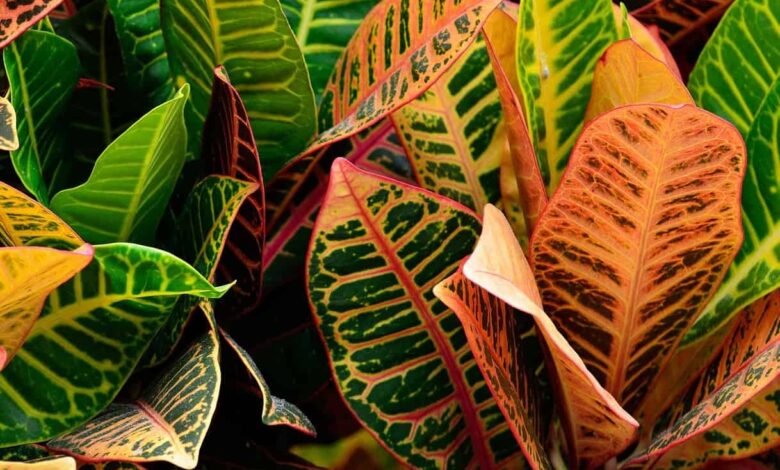
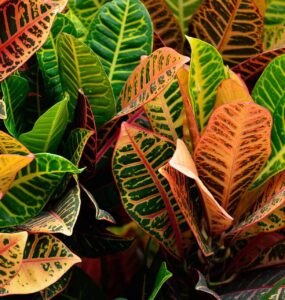 The Croton or Codiaeum Variegatum Pictum, belonging to the Euphorbiaceae family, is a fabulous indoor plant , thanks to the color of its large leaves.
The Croton or Codiaeum Variegatum Pictum, belonging to the Euphorbiaceae family, is a fabulous indoor plant , thanks to the color of its large leaves.
These are its main attraction and therefore it is considered an ornamental plant . They are hard, with ribs of perfect colorful brushstrokes in yellowish , orange , green , purple, pink , cream, black and reddish tones that attract the attention of everyone.
Croton characteristics
The croton is a plant native to the southern Pacific area (Malaysia, Polynesia and Australia) its average height is about 90 centimeters and if it is well cared for, its foliage will be generous and unique. It will shine in the home wherever you want to grow it.
There are varieties with very wide leaves, more elongated, shorter, with contrasting combinations and colors.
Keep in mind that when buying a creton, what is the variety that you are taking from your trusted nursery, because there are higher or lower light and humidity requirements in certain species.
Maintaining more or less the same conditions that it had before arriving at your home, will guarantee that it does not lose foliage. The croton is considered a delicate plant because it does not like to be moved.
Some of the following keys will allow you to enjoy croton for a very long season.
Temperature: Where to plant the croton?
 Ideally, keep the croton at a constant room temperature, 20 ° C would be excellent. But it supports a range that ranges from 18 ° to 24 ° C and up to 30 ° C. The minimum that it holds is about 15 ° C.
Ideally, keep the croton at a constant room temperature, 20 ° C would be excellent. But it supports a range that ranges from 18 ° to 24 ° C and up to 30 ° C. The minimum that it holds is about 15 ° C.
Remember, however, that its Tropical origin makes you not like the cold.
It should not be exposed to cold drafts or sudden changes in temperature that generate significant stress, because it will not do well and its lush leaves will begin to fall.
If you activate a humidifier at home that contains distilled water, the croton will feel comfortable until it gets used to the new environment.
It needs, yes, a lot of humidity to stay alive. And if environmental heat is also lacking, it will progressively lose its leaves. Remember that it is a tropical plant, it does not tolerate low temperatures.
If you activate a humidifier at home that contains distilled water, the croton will feel better.
Luz: What needs do you have?
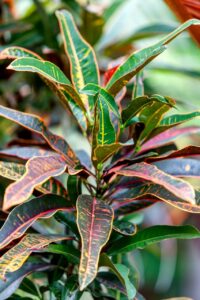 Very good direct light from time to time also very much like. Help her in meeting this minimum requirement so that the colors of her leaves are always alive and maintained.
Very good direct light from time to time also very much like. Help her in meeting this minimum requirement so that the colors of her leaves are always alive and maintained.
Consequently, you have to provide it with excellent natural lighting, so you should choose the space where it will stay very well.
Hence, we recommend looking for an area of the house that receives solar rays. Near a window would be perfect for the Croton. Abundant but not direct light is essential for its development, without affecting its variegated leaves, which can burn indiscriminately when they receive the sun.
That is why the croton is considered delicate in its maintenance. The light and the ambient temperature must always be carefully monitored so that this spectacular plant does not perish to complete decorations at home.
Substrate and Compost: How do we prepare the soil?
In spring and summer, apply an excellent quality liquid fertilizer every 15 days.
A fresh substrate , containing very good quality peat, is a good gift for the Croton.
An optimal mix to achieve a high quality substrate, mix mulch and sand in equal parts.
Irrigation: How and how often do we water?
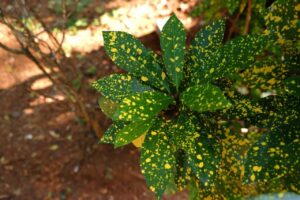 Irrigation will be equally constant, but not exaggerated, because its roots must always be taken care of so that they do not get puddled because, like any plant, if this happens it will rot from its entrails.
Irrigation will be equally constant, but not exaggerated, because its roots must always be taken care of so that they do not get puddled because, like any plant, if this happens it will rot from its entrails.
The soil must be dry so that a new irrigation can begin.
In the growth period, the waterings will be increased wisely and the key to not losing the leaves is to carry out frequent spraying.
A weekly watering is appropriate.
Between the months of May to September, which is the time when it takes on splendor, use a liquid fertilizer for green plants. This will delight your croton.
And take advantage of this moment to clean its strong smooth blades. Use a rinse aid that does not contain any gas. Spread it out and then pass a clean balleta to make the blade dust-free and shine, once a month.
Croton care
- Place Croton in a sunny location such as a window facing east, south, or west. If a croton gets too little light, its new leaves will be less colorful.
- Keep the soil evenly moist, but allow it to dry out between waterings.
- If humidity is low in your home, spray around the leaves with water once a week or put a wet gravel tray near the plant.
- Croton blades are dust magnets. Gently wipe the sheets with a damp cloth twice a month to keep them clean and dust-free.
- Fertilize the plant in spring and summer .
- New croton plants can start with stem cuttings 4 to 6 inches long. Remove the lower leaves and place the cutting in a glass of water.
- After the roots have formed, plant the croton in a small pot.
- Replant in spring if it has grown too large for its current pot.
The croton plant can be toxic: Watch out!
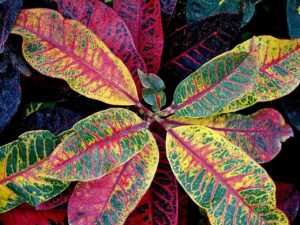 Croutons can be poisonous plants to keep in your home, especially if you have children or pets living with you.
Croutons can be poisonous plants to keep in your home, especially if you have children or pets living with you.
The milky sap that is inside the stem of the plant is toxic . The sap will cause indigestion problems, but it is not normally fatal to dogs, cats, or young children.
Swallowing the sap-filled seed pod can be a fatal mistake, so keep croton plants away from young children and curious pets.
Problems that the croton plant can have
Low humidity indoors makes croutons particularly susceptible to spider mites. Spray the plants daily to avoid an infestation.
Moisture, along with the lack of bright light, also affects the color of the leaves. Try to keep the humidity level between 40% and 80%. If the humidity is not high enough, the plant may drop some of its leaves.
If you have trouble keeping humidity between those levels, put a humidifier in the room or place a humidity tray under the plant. Put it together with other plants, this will make the environment more humid.

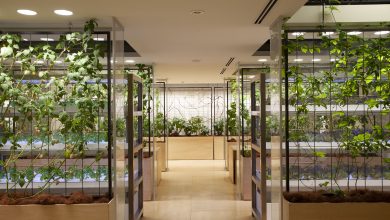


![Photo of Cucurbitaceae: [Concept, Characteristics and Examples]](https://www.complete-gardening.com/wp-content/uploads/2022/08/cucurbitaceae-concept-characteristics-and-examples-354x220.jpg)